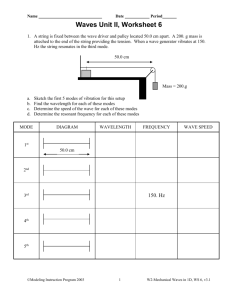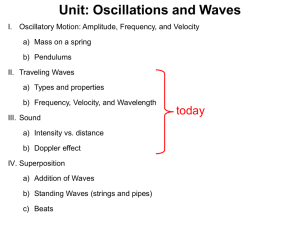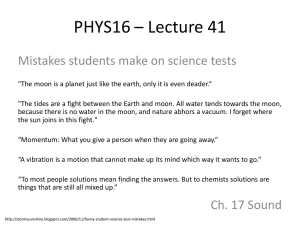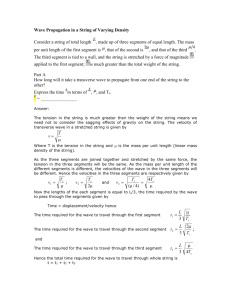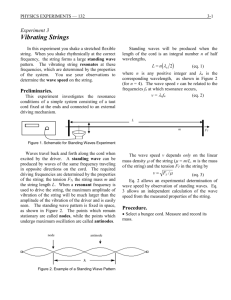Martin-Gay SSM
advertisement
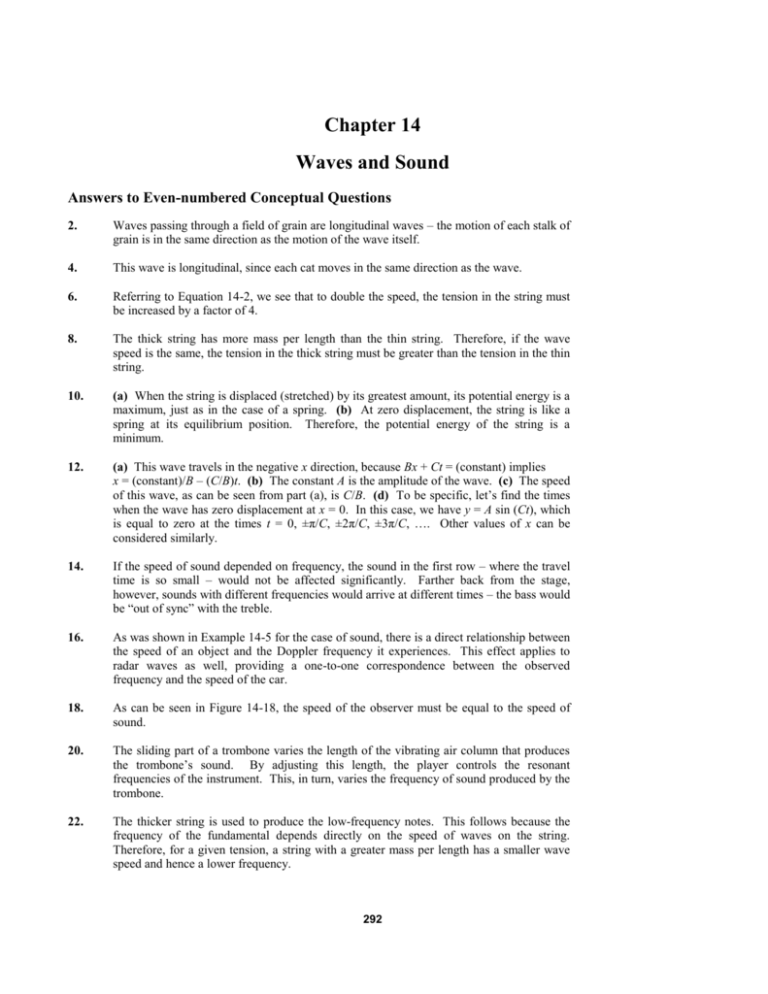
Chapter 14 Waves and Sound Answers to Even-numbered Conceptual Questions 2. Waves passing through a field of grain are longitudinal waves – the motion of each stalk of grain is in the same direction as the motion of the wave itself. 4. This wave is longitudinal, since each cat moves in the same direction as the wave. 6. Referring to Equation 14-2, we see that to double the speed, the tension in the string must be increased by a factor of 4. 8. The thick string has more mass per length than the thin string. Therefore, if the wave speed is the same, the tension in the thick string must be greater than the tension in the thin string. 10. (a) When the string is displaced (stretched) by its greatest amount, its potential energy is a maximum, just as in the case of a spring. (b) At zero displacement, the string is like a spring at its equilibrium position. Therefore, the potential energy of the string is a minimum. 12. (a) This wave travels in the negative x direction, because Bx + Ct = (constant) implies x = (constant)/B – (C/B)t. (b) The constant A is the amplitude of the wave. (c) The speed of this wave, as can be seen from part (a), is C/B. (d) To be specific, let’s find the times when the wave has zero displacement at x = 0. In this case, we have y = A sin (Ct), which is equal to zero at the times t = 0, ±π/C, ±2π/C, ±3π/C, …. Other values of x can be considered similarly. 14. If the speed of sound depended on frequency, the sound in the first row – where the travel time is so small – would not be affected significantly. Farther back from the stage, however, sounds with different frequencies would arrive at different times – the bass would be “out of sync” with the treble. 16. As was shown in Example 14-5 for the case of sound, there is a direct relationship between the speed of an object and the Doppler frequency it experiences. This effect applies to radar waves as well, providing a one-to-one correspondence between the observed frequency and the speed of the car. 18. As can be seen in Figure 14-18, the speed of the observer must be equal to the speed of sound. 20. The sliding part of a trombone varies the length of the vibrating air column that produces the trombone’s sound. By adjusting this length, the player controls the resonant frequencies of the instrument. This, in turn, varies the frequency of sound produced by the trombone. 22. The thicker string is used to produce the low-frequency notes. This follows because the frequency of the fundamental depends directly on the speed of waves on the string. Therefore, for a given tension, a string with a greater mass per length has a smaller wave speed and hence a lower frequency. 292 Physics: An Introduction Chapter 14: Waves and Sound 24. The sound produced after taking a sip is lower in frequency. This is because the vibrating column of air is now longer, which means that the wavelength of the sound is longer as well. Since the speed of sound is the same, it follows that the frequency is reduced. 26. You have just observed a series of beats between your wipers and the wipers of the other car. 28. You hear no beats because the difference in frequency between these notes is too great to produce detectable beats. Solutions to Problems 4. f v 1h 750 103 m h 3600 s F 12. v vA vB 310 10 m 3 6.7 104 Hz , and a doubled diameter means a quadrupled cross-sectional area, thus a quadrupled mass per length, . FA B A FB 4.0 FA FB 410 N 4.0 820 N 1.4 20. (a) t 2 (b) 22. (a) 75 m d 0.098 s 2 1530 m v s v 1530 m/s 28 103 m 28 mm f 55 kHz 343 ms v 0.817 m f 420 Hz (b) It decreases, because varies inversely as f. (c) 343 ms 450 Hz 0.762 m 24. fall time = total time – sound travel time d 8.8 m ts 0.0257 s v 343 m s tf 1.2 s 0.0257 s 1.1743 s 293 Chapter 14: Waves and Sound Physics: An Introduction 1 y y0 v0tf atf 2 2 y y0 1 v0 atf tf 2 8.8 m 1 m 9.81 (1.1743 s) 1.1743 s 2 s2 1.7 m s speed = 1.7 m/s 32. P = IA, where A r 2 (4.0 103 m)2 5.0 105 m2 . 12 W 5 2 17 W (a) P 10 (5.0 10 m ) 5.0 10 m2 W (5.0 105 m 2 ) 5.0 10 –5 W (b) P 1 2 m 34. Moving source: v f f v u f v u v f f u 1 v f m 450 Hz 1 343 470 hz s 15 m s 38. 1 uo v f 1 us v 13.0 ms 1 343 m s f 27.0 ms 1 343 m s (512 Hz) 577 Hz 42. (a) The pilot of the jet on the ground hears a greater Doppler shift, because Doppler effects are greater with a moving source. (b) Moving observer: 9 f (1 uv ) f 1 (400.0 Hz) 760.0 Hz 10 (c) Moving source: 1 1 f (400.0 Hz) 4.000 kHz f 1 u 1 9 v 10 294 Physics: An Introduction 44. Chapter 14: Waves and Sound u f 1 o f v u 1 = 1+ o f v 1 us v us uo f 1 1 f v v f u uo 1 s 1 v v f 131 Hz 32 ms 1 1 343 m s 125 Hz 343 ms 50 m s 60. (a) The number of antinodes equals the number of the harmonic: 3. (b) 1 1 2 2 L, so L (62 cm) 41 cm 2 3 3 3 64. (a) The wave corresponds to f 2 2 f1 , so f1 1 (232 Hz) 116 Hz . 2 v 2L v L 2 f1 343 ms 2(116 Hz) 1.48 m (b) f1 68. f 2 f1 f beat 441 Hz 8.00 beats 445 Hz 2.00 s 70. (a) An increased beat frequency means a larger frequency difference. So, the 320.0 Hz fork has the lower frequency. f beat f unknown fknown (b) f beat f known f known, 2 f known,1 f known f known,1 f beat 320.0 Hz 3.0 Hz 317.0 Hz (c) funknown f known,1 fbeat,1 320.0 Hz 4.50 Hz 324.5 Hz 295


